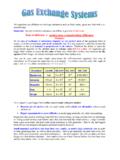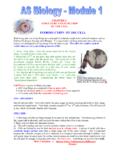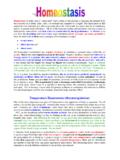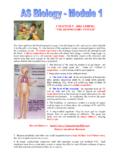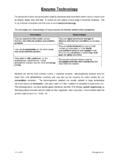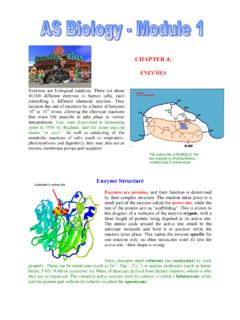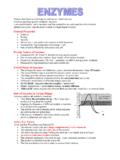Transcription of Continuous and discontinuous variation - …
1 Continuous and discontinuous variation variation , the small differences that exist between individuals, can be described as being either discontinuous or Continuous . discontinuous variation This is where individuals fall into a number of distinct classes or categories, and is based on features that cannot be measured across a complete range. You either have the characteristic or you don't. Blood groups are a good example: you are either one blood group or another - you can't be in between. Such data is called discrete (or categorical) data. Chi-squared statistical calculations work well in this case. discontinuous variation is controlled by alleles of a single gene or a small number of genes. The environment has little effect on this type of variation .
2 Continuous variation In Continuous variation there is a complete range of measurements from one extreme to the other. Height is an example of Continuous variation - individuals can have a complete range of heights, for example, , , , etc metres high. Other examples of Continuous variation include: Weight; Hand span; Shoe size; Milk yield in cows Continuous variation is the combined effect of many genes (known as polygenic inheritance) and is often significantly affected by environmental influences. Milk yield in cows, for example, is determined not only by their genetic make-up but is also significantly affected by environmental factors such as pasture quality and diet, weather, and the comfort of their surroundings.
3 When plotted as a histogram, these data show a typical bell-shaped normal distribution curve, with the mean (= average), mode (= biggest value) and median (= central value) all being the same. Standard Deviation ( ) This is a measure of the variability of a data set. Put simply, the taller and narrower the histogram, the lower the SD ( ) and the less variation there is. For a low, wide, histogram, the opposite applies: Standard Error is a refinement of this, which takes into account sample size (n). The formula is: Sampling Error When collecting data, it is vital that the data is reliable and reflects real differences in the population. This can be ensured by having a large data size, but it is also necessary to ensure that the data collected is typical of the whole population in other words, that it is randomly collected.
4 In the laboratory, we repeat experiments 3 times and/or pool class data. In field-work, we use random number tables; grids laid out with tape-measures, and large numbers of quadrats to ensure that our data are reliable and randomly collected. It is easy to (unwittingly) introduce bias into the collection of results, and to avoid bias is an important point to make in your answers to questions on this topic Causes of variation variation in the phenotype is caused either by the environment, by genetics, or by a combination of the two. Meiosis and sexual reproduction introduces variation (see Ch 1), through Independent assortment of the parental chromosomes; through Crossing-over during Prophase I; and through the random fertilisation that forms the zygote.
5 Mutations These changes to the genetic make-up of an individual which cannot be accounted for by the normal processes (above) may (rarely) involve chromosomal mutations ( Down s Syndrome, where an individual has trisomy (= 3 copies) of chromosome 21; they therefore have 47 chromosomes), but more commonly, these mutations are confined to a single gene and are known as gene mutations. Since DNA replication is not perfect, with an error rate of about 1 in 1012 bases, we gradually acquire more of these during our lives. Certain chemicals and radiation increase this error rate, but note that 99% of our DNA is junk DNA and so the vast majority of mutations are unlikely to have any effect whatsoever. Base deletion means a single base is omitted.
6 This will affect all subsequent amino-acids in that protein and the effects are therefore likely to be severe. Base substitution means that one base is replaced by another. This will only affect a single amino-acid, and normally this has little effect unless the active site of an enzyme is affected. One example where the effects are dramatic is sickle-cell anaemia, which is caused by a single amino-acid substitution (see later notes) Population IA IBIO African 15 1075 Caucasian 30 1555 Orientals 20 2258 Amer. Indians 0-55 0 45-100 Australasian 50 0 50 Worldwide 22 1662 Europe 22 1167 Gene pool This is the total number of alleles (note, not genes!) in a breeding population. A human population will have 3 alleles for blood groups (A, B, O).
7 Since everyone must have one of each of these alleles, the total frequency must be and the frequency of each allele can then be expressed as a decimal. In the above case, the frequencies vary greatly amongst different ethnic groups (see table) Hardy Weinberg This principle states that the proportion of the different alleles in a gene pool (breeding population) only changes as a result of an external factor. Thus providing the following assumptions are met, each generation will be the same as the present one: Large population No migration either in (immigration) or out (emigration) There is random mating No mutations occur All genotypes are equally fertile Worked Example: In a population containing 2 alleles, T and t, three genotypes will exist TT, Tt and tt.
8 If T is a dominant allele, then it is impossible to tell which individuals are Tt and which are Tt. It will also be impossible to tell the relative proportions of these two genotypes. The Hardy-Weinberg equation allows us to calculate that. Stages in the calculation: Let the proportion of T alleles = p and the proportion of t alleles = q. Then: p + q = 1 Both p and q are decimal fractions, and therefore both will be less than That means that the proportion of the different genotypes is: TT individuals are p2; Tt individuals are 2 pq; and Tt individuals are q2 Since that is the whole population, it follows that: 1 = p2 + 2pq + q2 Now, we can see, and count, those individuals that are tt (double recessive), so: 1. Work out the proportion (as a decimal fraction, 5% = ) of tt individuals in the whole population.
9 The question will give you this data, so just use your calculator! 2. Take the square root of that number. That gives you q 3. Since p + q = 1, you can now calculate p (it is 1 q). 4. Substitute the values you now have in the equation 1 = p2 + 2pq + q2 to give you the decimal fraction of each of the genotypes. 5. If the question asks you to calculate how many individuals in then population , then multiply the number you have (for the required genotype) by the total population. Remember that you cannot have a fraction of an individual, so round up/down to the nearest whole number. 6. Easy, isn t it! Natural selection The Hardy-Weinberg equation requires such stringent conditions to be met, that, in the real world, it is seldom, if ever, true.
10 Thus, the equation is used to show that populations change over time, something we normally call evolution. The driving force behind evolution is natural selection, and this can occur in three main ways: Stabilising selection: This is the most common, and is a response to a stable environment. A good example is birth weight, since under-weight babies are clearly less likely to survive, and over-weight babies are likely to get stuck during birth, killing not only themselves, but also their mothers! The result is that the mode stays the same, but the SD of the population falls, the population graph gets narrower and taller, as selection against mutations takes place. This is most apparent in small, isolated populations, or when a bottleneck event takes place.
